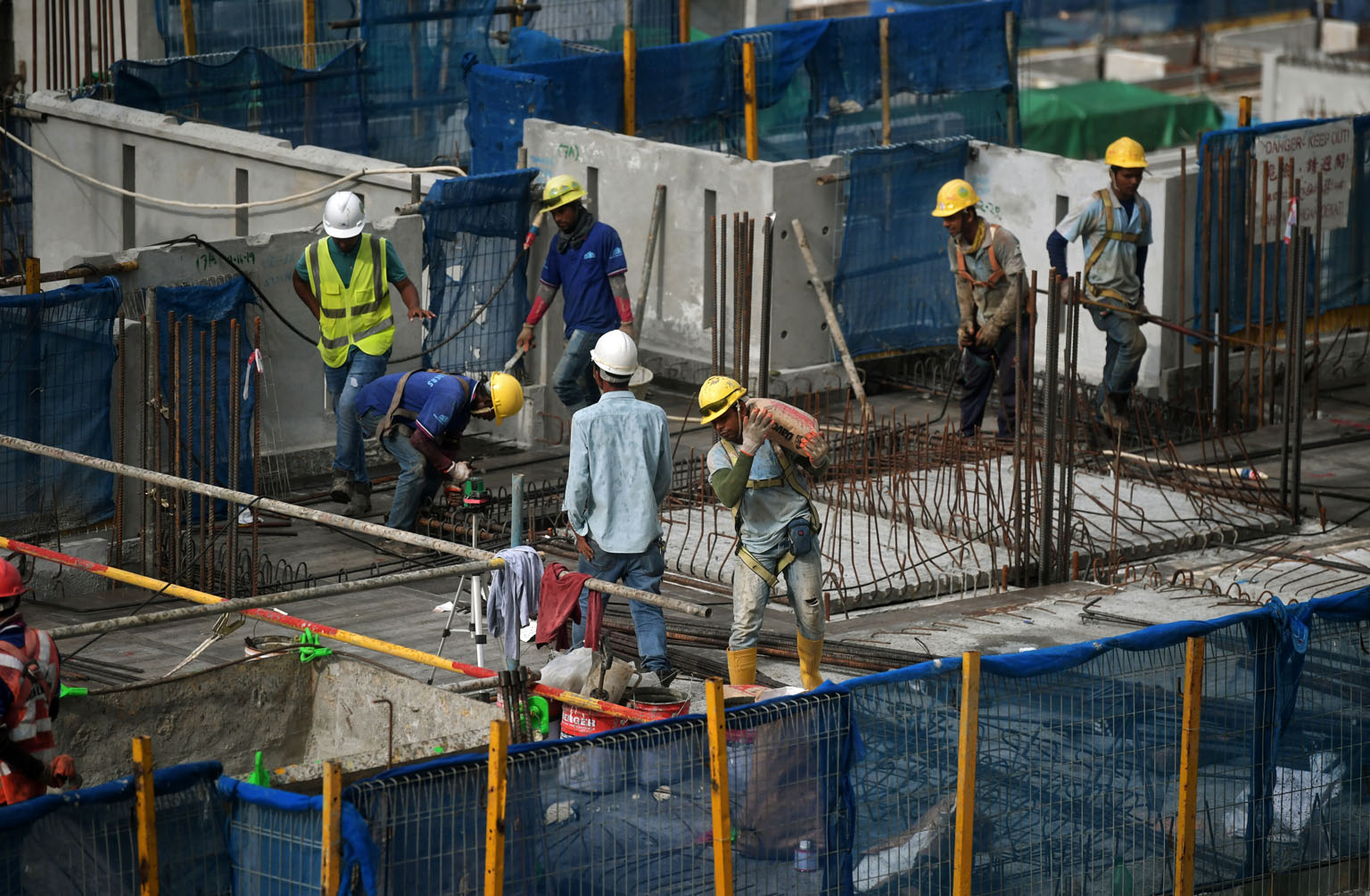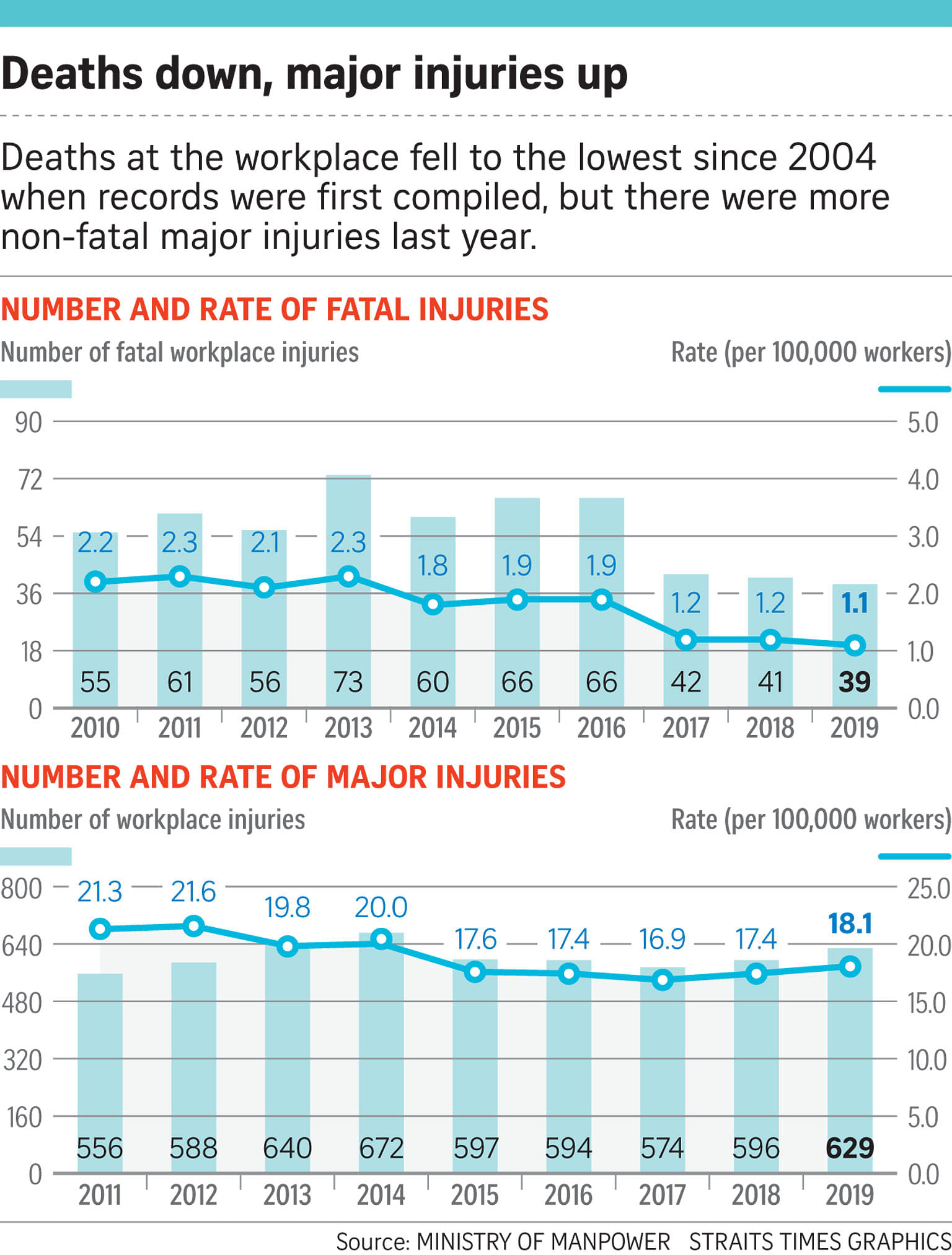Workplace fatalities fall to record low in 2019; injuries rise
Top cause for injuries was slips, trips and falls; MOM course to include experiential training
Sign up now: Get ST's newsletters delivered to your inbox

MOM will add an experiential training component to the current construction orientation course on workplace safety and health for new workers and those who failed the competency test.
ST PHOTO: KUA CHEE SIONG
Follow topic:
The number of workplace fatalities in Singapore last year fell to a record low, but this improvement was blunted by a rise in major and minor non-fatal injuries.
To reduce the rate of injuries, the Ministry of Manpower (MOM) said it will include experiential training in a course for construction workers and make it mandatory by 2022.
Workplace deaths fell to 39 last year, or 1.1 per 100,000 workers, according to MOM data out yesterday. This is compared with the 41 deaths in 2018 and marks the lowest rate of fatalities since 2004, when records were first compiled.
Non-fatal major injuries increased by 5 per cent last year to 629 cases. Major injuries usually involve the loss of a body part or function, and include amputation, fractures, blindness or conditions that require medical leave of more than 20 days.
Minor injuries, which involve conditions that require medical leave of four days or more, rose by 8 per cent to 13,111 cases last year.
The top cause for both major and minor injuries was slips, trips and falls, with construction workers, drivers, cleaners and security guards being most prone to major injuries because of this.
Major injuries rose in the manufacturing, accommodation and food services, and wholesale and retail trade sectors. Fatalities also doubled in transport and storage, especially water transport.
MOM found the fatal injury rate for construction workers who worked for less than three years was higher than that for their more experienced counterparts. To better train workers, MOM will add an experiential training component to the current construction orientation course on workplace safety and health for new construction workers and existing staff who failed the competency test that is taken at least once every two years.
This will use technology such as virtual reality to simulate high-risk situations like falling from heights.
Mr Quek Chin Tuan, executive manager of the Singapore Institution of Safety Officers (Siso), said: "We believe this programme will heighten safety awareness at worksites among construction workers."
Siso is planning a safe lifting clinic for lorry crane operators, under a programme which will begin later this year.
MOM will also step up education and inspection efforts for lower-risk industries, such as accommodation and food services and wholesale and retail trade. For instance, a workplace safety and health module will be made mandatory for cleaners in 2022.

Mr Silas Sng, commissioner for workplace safety and health and divisional director of MOM's occupational safety and health division, said: "To counter the rising trend of non-fatal injuries, companies must conscientiously address slip, trip and fall risks by educating workers and implementing risk control measures.
"The construction industry also needs to take ownership by inculcating safety mindsets and retaining experienced workers, who tend to be more risk-aware."
In total, MOM conducted 17,000 workplace inspections, which uncovered more than 8,900 contraventions such as obstructed passageways and unsafe means of access at worksites.
It issued 58 stop-work orders. Composition fines amounting to around $1.42 million were imposed on close to 1,000 companies.
Plans are under way to develop the workplace health and safety capabilities of 1,000 union leaders and industrial relations officers by March next year.
-
Better workplace safety and health
Measures taken by the Ministry of Manpower to improve workplace safety and health:
• Enhance the construction safety orientation training course to include experiential elements that can simulate high-risk situations, such as falling from heights.
• Make this course mandatory by 2022.
• The Workplace Safety and Health Council to form a roofing contractors association this year with the Specialists Trade Alliance Singapore, to help prevent falls.
• Release reports periodically to help industries glean insights into major workplace accidents and prevent recurrence.
• A report will be released this year on a fatal crane incident at a Novena worksite last year.
• Launch a safe lifting clinic in July to advise small and medium-sized enterprises that own or use lorry cranes.
• Work injury compensation insurance premium to be based on track records, so safer companies pay less.
• Public sector developers to have harmonised disqualification criteria for construction projects, so safer companies get better opportunities.
Sue-Ann Tan
The Singapore Contractors Association (Scal) said it supports these initiatives.
"Scal does not take safety for granted. We are continuing with our training programmes and outreach activities to generate greater awareness and capability building for smaller firms, including new ways to drive adoption of technology for better outcomes in workplace safety and health management," it said.

